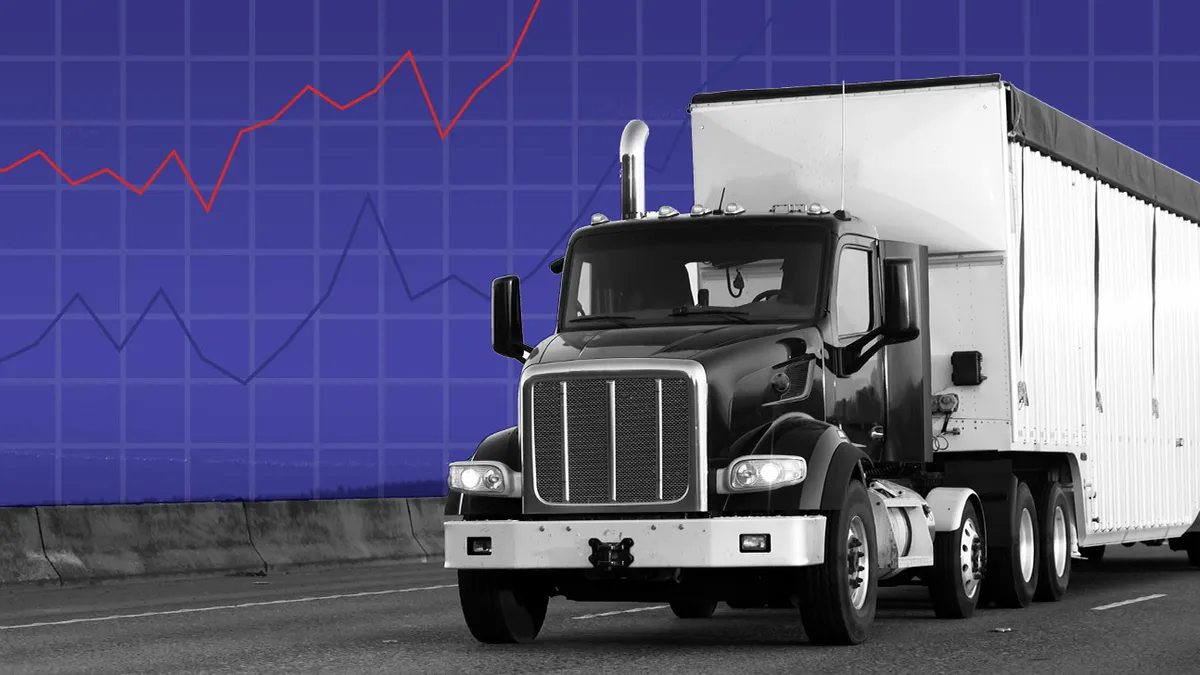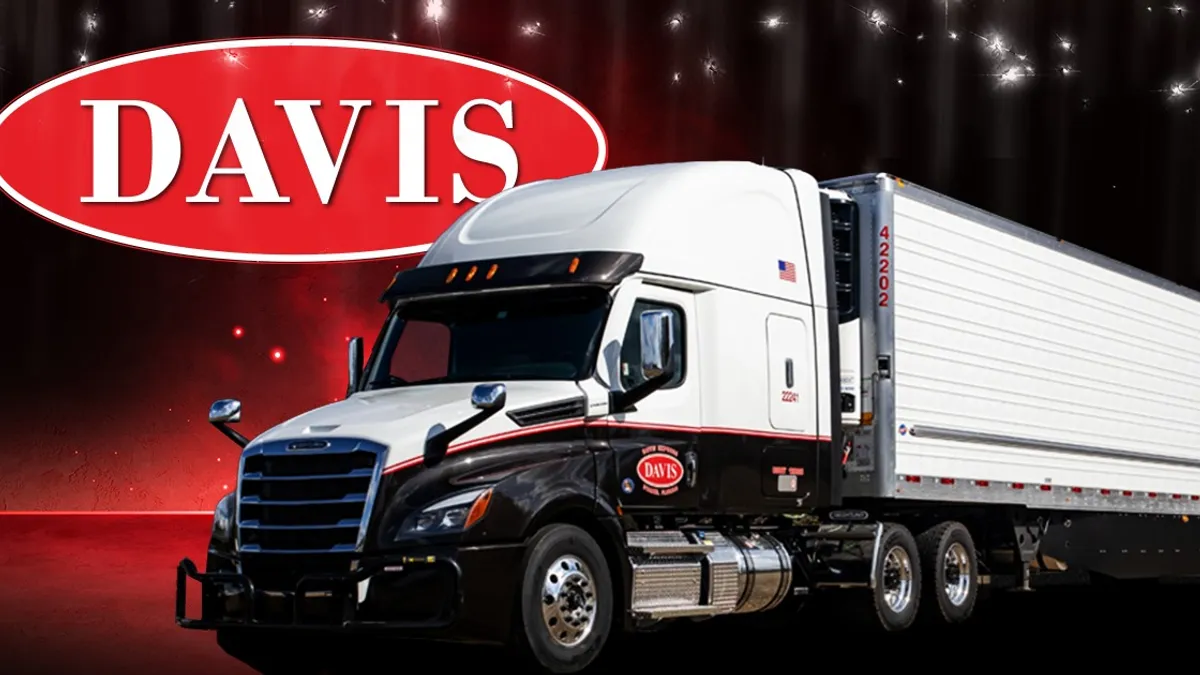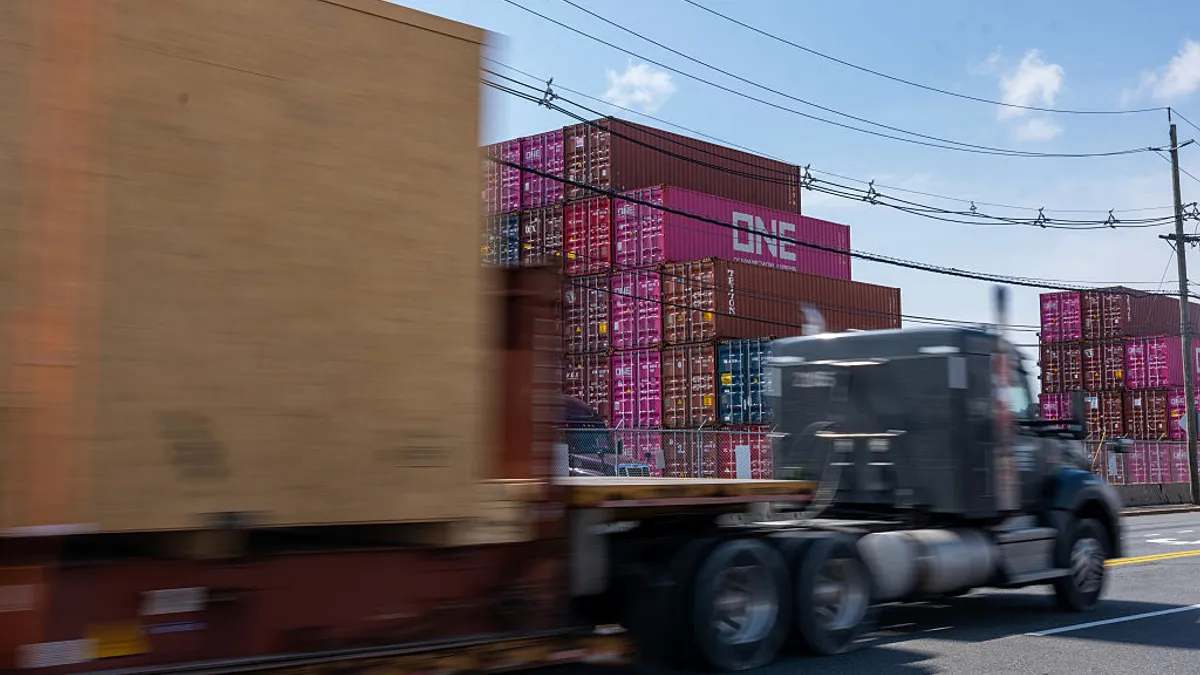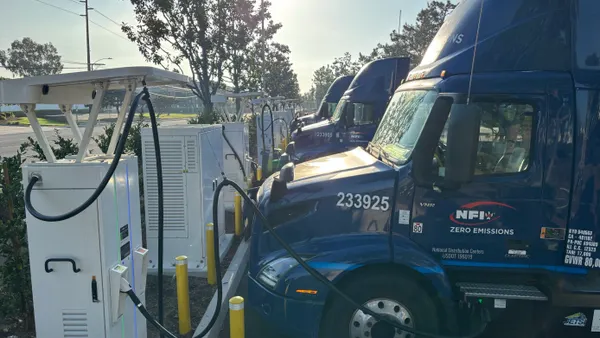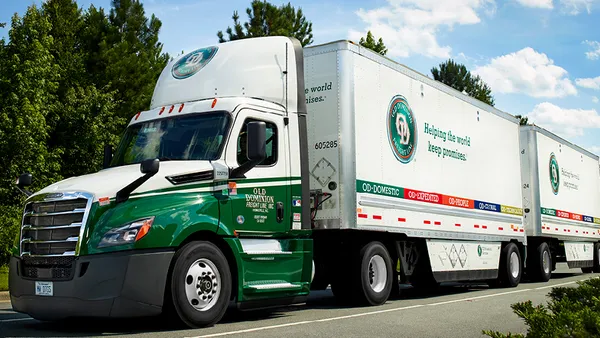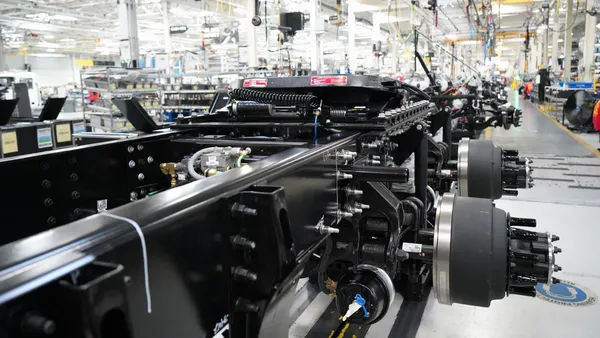States are gradually beginning to reopen businesses, after panic buying followed by stay-at-home mandates sent trucking activity on a roller coaster ride of climbs and dips.
From mid-March to mid-April, all but seven states contained lockdown orders, most of them applicable to state-wide operations. This had a direct impact on the transport industry but varied state to state, industry to industry.
Some carriers felt the shock of automotive plant closures, while others were boosted by surging grocery demand. Some fleets were forced to park trucks as oil prices tanked, while others kept busy moving consumer goods.
No industry in any state, though, has gone untouched by the pandemic. Here's a look at weekly truck activity in seven states from February through April.
On the West Coast
California Gov. Gavin Newsom was the first governor to order a state-wide, stay-at-home mandate. California, a state with active freight movement, experienced a slight peak in trucking activity the week of March 1. Activity has been steadily dropping ever since.
California Trucking Association President Greg Dubuque said he felt an abrupt change when Newsom issued his order on March 19. "The world came to a stop here," he told Transport Dive.
Dubuque is also the president of Liberty Linehaul West, a Los-Angeles-based, over-the-road trucking company. The business was getting a lot of retail work, but then 50% of its volume fell off, he said.
"It was a taper effect over the course of a couple of weeks from that point," Dubuque said. "It took a week and a half to two weeks for things to fall just right off here, with a lot of the durable commodities we haul."

California is the third-largest state in the U.S., with the country's largest ports in its southern half. Import volumes declined at the ports of Long Beach and Los Angeles in March. The former saw a 5% dip in volume that it blamed on 19 blank sailings that led to a 6.9% drop in cargo shipments. The latter saw imports fall 26% year over year in March, which the port said was the "lowest amount of monthly cargo moving through the port since February 2009."
The Port of Oakland handles a lot of outbound commodities from the Midwest and elsewhere in the country. Dubuque said volumes from that segment also dried up.
"This definitely isn't an industry for the meek; the margins just aren't there. And it's just a matter of trying to survive to a better day here."

Greg Dubuque
President, California Trucking Association
"[The state economy] was affected on two different segments here that way, with the port carriers and the supply chain," Dubuque said. "How that affects us is the trickle-down effect. With the shipments not coming off the ships into the warehouses to be [reorganized] for distribution, we don't have that volume of product that we're taking to hit the store shelves."
But some conditions in California haven't changed, he said. Trucking companies still need to pay insurance, and the cost to own a company and property are higher in California than in many other states.
"It's really gonna be, I think right now, a survival of the fittest. This definitely isn't an industry for the meek; the margins just aren't there. And it's just a matter of trying to survive to a better day here," Dubuque said.
In the Midwest
A decline in OEM manufacturing, and reliance on intermodal freight, resulted in similar truck activity in Ohio, Illinois and Minnesota. Activity in the three states peaked the week of March 8 and hit lows the weeks of April 5 and 12.
"One auto plant has a beyond outsized effect on the freight volumes in a given area ... what happens if we have a plant closure of that magnitude?" Jason Miller, associate professor of logistics at Michigan State University, told Transport Dive. Navistar, Kenworth, Honda and others have plants located in Ohio.

Some trucks were moving supplies for manufacturers, as OEMs stocked up on supplies in the hopes of staying in operation. That boosted flatbed business and had dry-van businesses moving a bit, as well, said Illinois Trucking Association Executive Director Matt Hart. "Right now, though, we are beginning to see a fall off in freight, a slow down in production," he told Transport Dive.
Along with manufacturers' production suspensions, closures in retail, hospitals and schools closures caused activity to slow in Illinois, Hart said.

"Intermodal is probably hurt the most," he said, due to shutdowns in Asia when coronavirus was first rearing its head in January. "We're still waiting for the imports to come over from Asia. That slowed a lot of the retail products around the Chicagoland area, and we're hopeful those will pick up soon. Other industries, it's kind of been up and down."
But not all segments have dried up. "Anybody who's in durable goods had a really good end of March, because we were moving a lot of groceries, moving a lot of essential products and just going as hard as fast as we possibly could," Hart said. Grocery demand has slowed down as panic buying has subsided, but the segment is still faring well, he said.
Even though Minnesota's busiest week was not significantly busier than previous four, truck movement fell drastically from March 22 to April 11. It picked back up right after, however. Jason Miller pointed to the food industry in Minnesota; General Mills' world headquarters is in Minneapolis. Mid-March, the company predicted consumer habits resulting from the pandemic would boost its 2020 earnings.

On the East Coast
New York Gov. Andrew Cuomo was part of the first wave of governors to issue stay-at-home mandates. The state saw peak trucking activity the week of March 8, likely in correlation with consumer panic-buying, before it dipped to its lowest point the week of April 5 and then rebounded slightly.
In New York City, TL volume was down 14% the week of March 23, compared to the previous week, according to FourKites. The following week, volume dropped 10%.
"No city has suffered bigger interruptions than New York," Vivek Vaid, FourKites CTO, wrote in a blog post. "As the nation's largest and densest metropolitan area, any fluctuations in the supply chain were likely magnified disproportionately compared to other metropolitan areas."

Pennsylvania's stay-at-home order didn't come until a week and a half after New York's. But because Pennsylvania is the distribution hub of the Northeast, Jason Miller said, panic-buying patterns in the Northeast are reflected in the state's truck activity.
Many consumer packaged goods are dispatched out of the state capital, he said, making Harrisburg the driving force behind the spike of activity in the state.

Florida Gov. Ron DeSantis was one of the last to issue a state-wide order. Trucking activity in the Sunshine state didn't reach a significant peak, as activity stayed somewhat steady reaching a high the week of March 8. But it did drop off dramatically after March 14.
"We have one of the largest influxes of cars coming from Jaxport in Jacksonville, that moves from Jacksonville up north to provide cars to car dealerships. That's definitely fallen off," Alix Miller, VP of the Florida Trucking Association, told Transport Dive. "You have to think about our stadiums, our tourist attractions, our hotels our universities. Normally, companies would be shipping products to those facilities and they are not open."
Home construction, another big industry for Florida, has also slowed considerably, she said.

Moving freight in the peninsula is not always an ideal scenario, as the chance of getting a backhaul can be low. But because there's been a 10% or more reduction in the usual volumes of contract freight that shippers have tendered to carriers, Jason Miller said, and no change in trucking capacity, some fleets will be forced to take less-than-ideal jobs.
"You're probably going to be deadheading a lot and running up your costs. But you're still going to take that load right now, because it's better than not hauling anything," he said.
Consequences of a down market
Load demand caused by panic-buying spiked trucking activity across the country. In some states, declining activity levels at the end of March were instances of normalization, while in others the declines represented devastating slumps.
In Illinois, how members are faring "truly is hit or miss," Hart said. Some companies still have everyone employed and are taking it day by day, he said. "One member in particular, he had everybody working today; tomorrow was looking good. Meanwhile, I know I've got other members who were still waiting on the intermodal freight to pick back up."
"There's thousands of trucks here in California ... there's going to be carriers that aren't going to live through this."

Greg Dubuque
President, California Trucking Association
While trucking companies across the country wait for the economy to rebound, some decide to look outside their usual business to keep trucks and freight moving. One place to do so is the open market, which Dubuque said "is just horrendous." Pricing has fallen by more than 50% and, because of the competition, the open market is not a sustainable way to do business, he said. "There's thousands of trucks here in California ... there's going to be carriers that aren't going to live through this."
Hart echoed those concerns.
"And that just adds more competition to the to the pool out there, which then drives down rates," he said. "Suddenly, manufacturers are hearing from other trucking companies who are saying, 'I can give you a better rate, I've got capacity, I can move those goods for you.' That is putting a lot of pressure on rates right now. And we don't know whether that's a short-term issue or if that's going to continue to be a long-term issue.”
Predictions are tough to make, as the coronavirus event is somewhat unique to economic history and therefore difficult to analyze.
"As long as people continue to eat and people continue to buy clothes and need things, the trucking industry will be there."

Matt Hart
Executive Director, Illinois Trucking Association
Old Dominion's CFO said the company would like to think the worst is behind it. Schneider projects the harshest impact of the coronavirus will be in Q2. Rajeev Dhawan, director of the Economic Forecasting Center at Georgia State University, told Transport Dive in early March, "the next three months will be horrendous by any metric."
"Your previous sources of revenue — they change. You got to find new ways to go out there and move freight," Hart said. "There is still freight to be moved out there. And as long as people continue to eat and people continue to buy clothes and need things, the trucking industry will be there."


